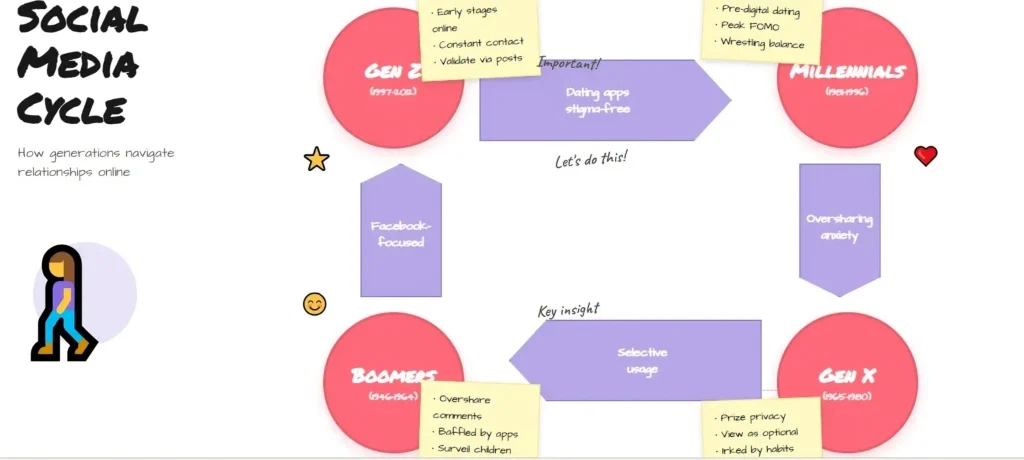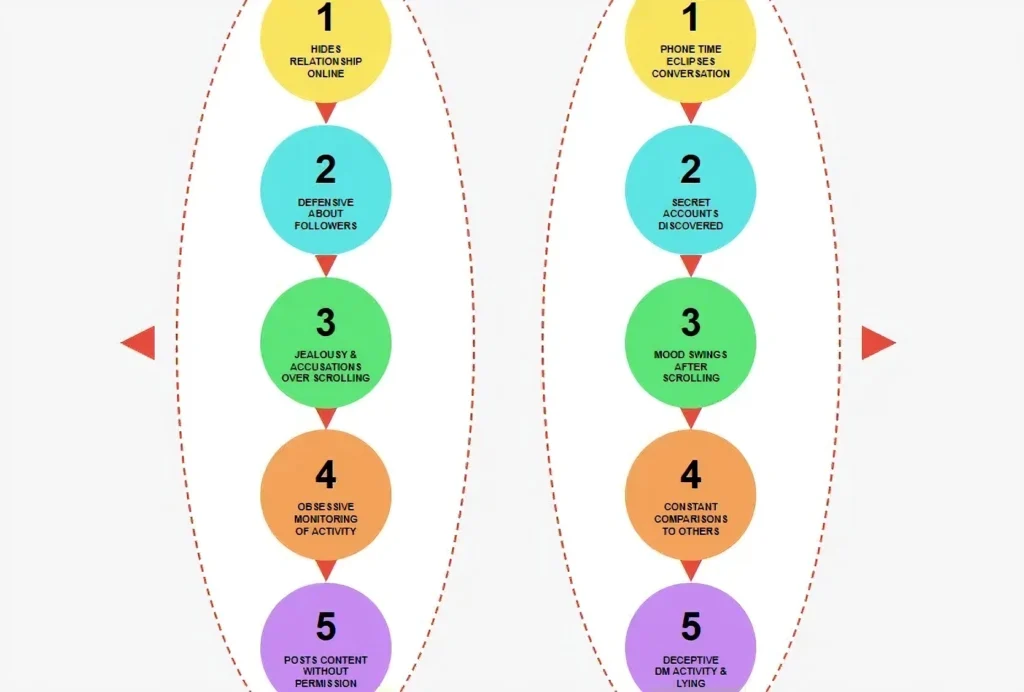The Last Breath of Käämyäjä
Stumbled across this old legend while digging through some dusty archives last week—Käämyäjä, that mythical serpent from ancient tales in...
Read moreNo products in the cart.
Social media has woven itself into the fabric of daily life, reshaping how people connect, communicate, and sustain bonds. From fleeting flirts to lifelong commitments, platforms like Instagram and TikTok influence every stage of human interaction. This shift brings both opportunities for deeper connections and pitfalls that strain ties. Drawing on recent data as of October 2025.
Table of Contents
ToggleEach social media site leaves a unique mark on relationships, often amplifying specific behaviors or pressures. Instagram, with its focus on visuals, fosters comparison through curated feeds—users scroll through “highlight reels” of others’ lives, sparking anxiety about their own partnerships. For instance, the pressure to match “couple goals” posts can lead to performative romance, where pairs stage photos for likes rather than genuine moments. One real-world example: a couple parted ways after a public spat in comments over a photo deemed too revealing, turning a private talk into a viral mess.
TikTok thrives on viral trends and quick advice, where strangers’ relationship tips gain millions of views, sometimes causing rifts if partners disagree on following them. Participating in challenges can bond couples, like duets or dances, but mismatched enthusiasm often breeds conflict. Twitter (now X) encourages public discourse, where arguments escalate under mob scrutiny—cancel culture can spill into personal lives, damaging trust. Dating apps like Tinder, Hinge, and Bumble have overhauled courtship, introducing the “paradox of choice” with endless swipes, normalizing ghosting where conversations vanish without explanation.
Snapchat’s ephemeral snaps create “streak” cultures, pressuring daily check-ins that feel obligatory, while screenshot betrayals erode privacy. Facebook, meanwhile, turns relationship statuses into public declarations, stirring politics over friend lists or resurfacing exes through memories. These dynamics show how platforms dictate interaction styles, often prioritizing visibility over intimacy.
Social media’s reach extends beyond romance, altering friendships, family ties, and professional networks. In friendships, it enables long-distance maintenance through shares and messages, but also breeds “performative” bonds—liking posts without real outreach. FOMO hits hard when seeing group hangouts excluded from, yet it aids rediscovering old pals, though some argue keeping them in the past avoids complications.
Family dynamics shift too: parents monitor adult kids’ profiles, sometimes overstepping boundaries, while grandparents adopt platforms to bridge gaps, sharing grandkid photos. Comment sections become battlegrounds for drama, and friending relatives blurs lines—should you accept mom’s request? Professionally, LinkedIn’s oversharing can skew perceptions, where colleagues’ posts affect office vibes, and networking demands authenticity amid curated profiles.
Communication has evolved from calls to asynchronous exchanges, with social media introducing nuances that heighten tensions. Read receipts build pressure; a message seen at 3 p.m. but unanswered until 9 p.m. sparks anxiety over intent. Reaction buttons—hearts or likes—substitute for deeper talks, diluting emotional depth. Story replies feel casual compared to direct messages, altering intimacy levels.
Voice notes emerge as modern letters, more personal than texts but less demanding than calls. Emoji misreads vary by age or culture—a thumbs-up might seem dismissive. Expectations for replies have shrunk; studies indicate people now anticipate responses within four hours, versus days for emails. Couples increasingly share memes or TikToks instead of conversing, favoring async modes over real-time phone chats.
The gray zone of “digital infidelity” has grown, encompassing behaviors once dismissed as harmless. Sliding into DMs blurs lines between friendly and flirtatious, especially if hidden. Keeping dating apps post-exclusivity signals doubt, while following exes stirs jealousy. Secret accounts hint at deception, and emotional affairs unfold entirely online without physical contact.
Generational views differ: Boomers often see any opposite-sex messaging as cheating, while Gen Z requires a physical element. A 2025 study shows 45% of couples disagree on online cheating definitions, with 30% admitting to social media infidelity per ZipDo stats. This mismatch fuels arguments, eroding trust.
Social media’s comparison trap deeply affects mental health in relationships. Seeing others’ seemingly perfect lives triggers FOMO—everyone else appears happier, more adventurous. Engagement announcements flood feeds, heightening anxiety for singles or struggling pairs; pregnancy posts sting for those facing infertility.
The “perfect partner” myth from edited images lowers satisfaction. Michigan State research links higher social media use to reduced relationship happiness, with users reporting more depression and anxiety. A 2025 CyberSmile report notes 85% of Gen Z feel unsatisfied comparing lives online.
To counter negatives, couples adopt strategies for balance. Screen-free zones like dinner tables or bedrooms foster presence; first hour post-work without devices aids reconnection. Vacations with posting limits preserve moments.
Privacy pacts clarify what’s shareable—discuss posting partner pics or kids’ images beforehand. Venting issues publicly? Off-limits to avoid escalation. Mutual follows versus separate accounts: some prefer full access for transparency, others value independence, but talk before following family or exes.
Monitoring crosses into distrust when snooping; sharing passwords feels like surveillance to many. Location apps serve safety but can control. Surveys reveal 68% of couples argue monthly over social media, underscoring boundary needs.

Social media revolutionizes LDRs, boosting success rates. Video calls replace letters, time zone apps coordinate, screen shares enable “together” viewing. Shared albums and updates maintain closeness beyond scheduled talks.
Challenges persist: over-monitoring tempts, text tones misread, strains amplify. Yet positives dominate; 75% of college students have LDR experience, with tech aiding. Pre-social media, success was lower; now, constant connection helps.
Breakups amplify pain digitally. Unfollow or block? Seeing exes’ posts in real-time hurts; mutual friends complicate loyalties. Status changes timing: immediate or delayed? Who deletes couple pics?
Announcements: public posts versus private messages. Stalking new partners tempts, apps remind of availability. Shared accounts require division. Stat: Average checks of ex’s media exceed 10 times in first month post-breakup.
Amid critiques, positives shine: sustaining distant ties, support groups for parenting or illness. Finding aligned partners via shared interests; LGBTQ+ communities thrive safely. Introverts pace connections comfortably.
Reconnecting with kin; milestones amplified for far-flung loved ones. Example: Marcus met his wife in a Facebook hiking group, chatting months before meeting—apps failed him before.
Posted relationships often mask truth—happy snaps follow fights. Content creators build brands on coupledom, pressuring authenticity. “Soft launches” tease partners vaguely; anniversary posts gauge care.
Studies link frequent posting to insecurity. Curating aesthetics trumps real bonds, fostering dissatisfaction.
Spot trouble early: partner hides relationship online, defensive about follows, accuses cheating over scrolling. Obsessive monitoring, unauthorized posts, deliberate jealousy via media.

Worry if phone time eclipses talking, secret accounts surface, moods swing post-scrolling, constant comparisons. Sliding into DMs or lying about activity signals issues.
Data underscores impacts: 16-50% of couples meet online globally. Average daily social media time: over 2 hours. Michigan State ties heavy use to lower satisfaction.
Breakup rates rose with social media; common arguments over usage. Gen Z most affected. Online vs. offline success: no long-term difference, but varied challenges.
Reclaim balance: weekly phone-free breakfasts, monthly full-day breaks, vacation check-ins limited. Rituals like walks, games, cooking sans screens.
Replacements: apps like Screen Time curb habits. Charge outside bedrooms; accountability with partners.
Online: intentional matches via profiles, text chemistry first, easy contact but ghosting rife, idealization risks.
Offline: attraction leads, compatibility discovered gradually, harder endings due to circles, less choice overload.
Research: similar long-term success, different hurdles.
Experts weigh in: Therapist Stan Tatkin notes, “There’s nothing more difficult than another person,” highlighting relational complexities amplified online. Psychologists cite comparison as key dissatisfaction driver. Sociologists observe norms shifting toward digital validation.
Reflect: Time on media with partner? Posting for jealousy? Snooping? Anxiety over unengaged posts? Recent fights? Comparisons? DM comfort?
High yeses suggest issues; low indicate healthy balance.
Meetings evolve: DM slides succeed if genuine, not creepy. Instagram courting via likes, stories; Twitter bonds over shared views. Facebook groups, Reddit subs, gaming lobbies spark connections.
1995: bar meets, slow calls. 2025: swipes, chats, video dates.
Risks loom: amplified stalking, abusive control via tracking, revenge porn. Catfishing scams; oversharing aids theft. Protect: limit shares, use privacy settings, discuss boundaries.
Ahead: VR dates, AI coaches, metaverse bonds. Gen Alpha may prioritize privacy; new apps could emphasize authenticity. Pendulum might swing back from oversharing.
NoodleMagazine Teams shares useful and helpful content, becoming a trusted source for readers looking for valuable information.
Stumbled across this old legend while digging through some dusty archives last week—Käämyäjä, that mythical serpent from ancient tales in...
Read more